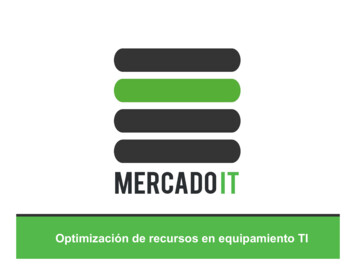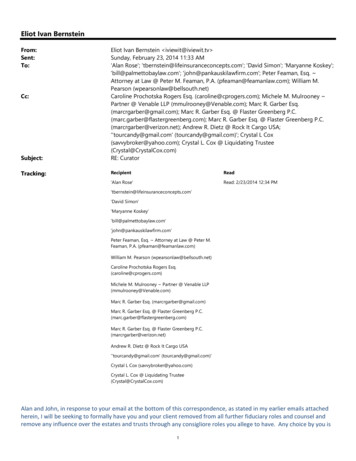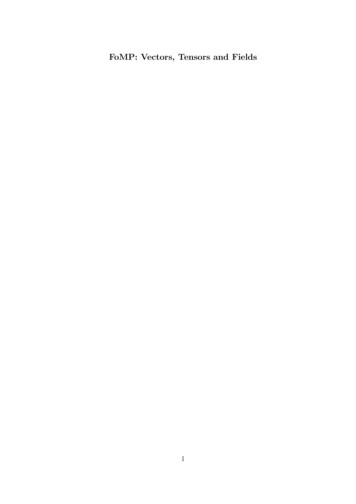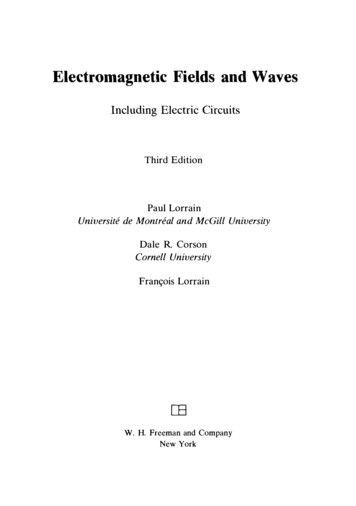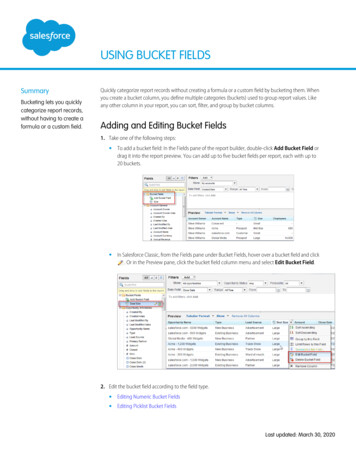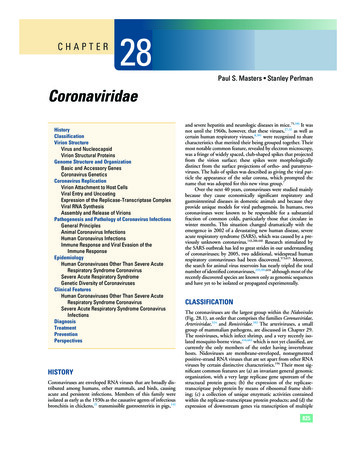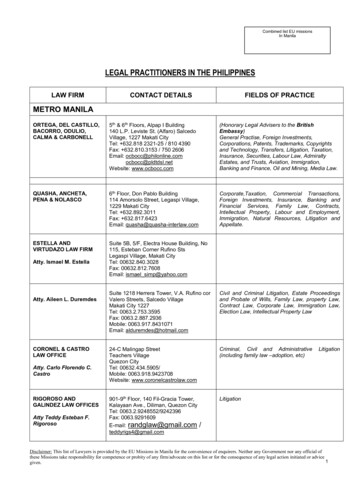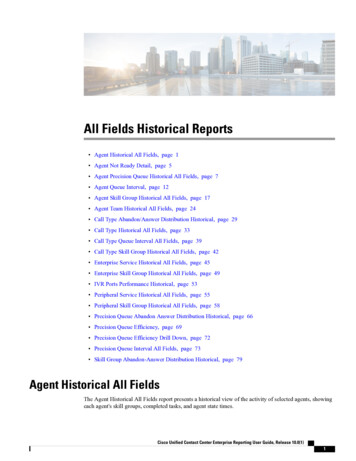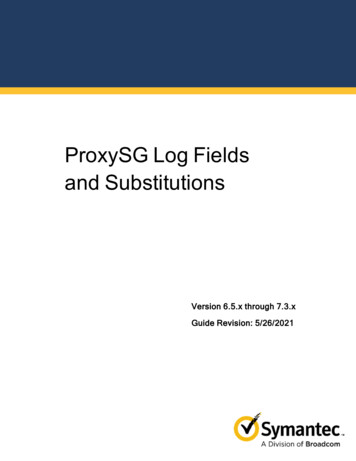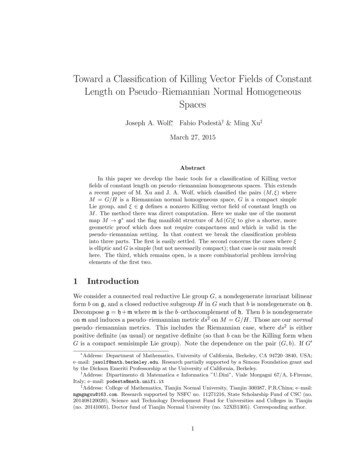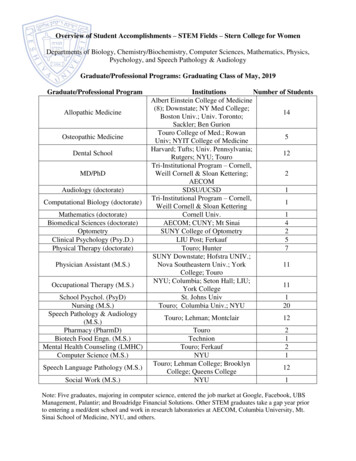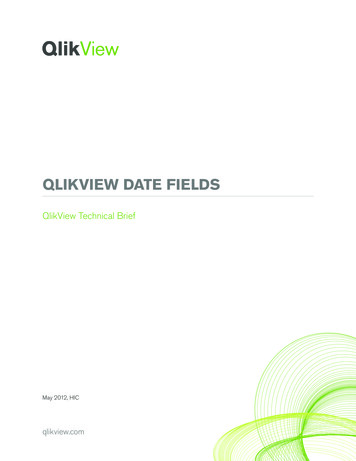
Transcription
QLIKVIEW DATE FIELDSQlikView Technical BriefMay 2012, HICqlikview.com
IntroductionIn most cases, you will have no problems loading dates in QlikView. The software has anintelligent algorithm to recognize dates independently of which region you are in. It usuallyjust works and you do not need to think about it. However, in some cases dates are notproperly recognized and then you need to add some code in the script to make it work.However, many of the questions on QlikCommunity concern dates and how to use datefunctions in QlikView. Although the basics for dates are fairly simple, there are manymisunderstandings. This technical brief is an attempt to give some background and somesuggestions. Those of you who are experienced QlikView users may not find anything newin this document, but others most likely will.Data typesFirst – there are no data types in QlikView. Instead QlikView uses a dual data storage for allfield values: every field value is represented by a string and – if applicable – a number. If a fieldvalue can be interpreted as a number (or a date) then a number is stored in the numeric part ofthe dual storage, while the display string is stored in the textual part of the dual storage.The serial numbers used for dates are the same as in Excel: the number of days passedsince the 30th December 1899 using the Gregorian calendar. The integer part of the serialnumber is the date and the fractional part is the time of the day. For example, if the 31st ofJanuary 2012 at 6 o’clock in the morning is loaded with US date format, then the number40939.25 is stored together with the string ‘1/31/2012 6:00 am’.This way dates, week days and month names can have textual names or arbitrary formatsand still be numerically sorted. The fields can also be used in numerical calculations andcomparisons and as continuous axes in graphs. Numerical functions always use the numericpart of the dual field and string functions always use the string part.QlikView Date Fields 2
Interpretation and formattingThere are two important types of QlikView functions that deal with time and dates:Interpretation functions and Formatting functions. The interpretation functions – e.g.Date#() and TimeStamp#() - are string-to-number conversions, i.e. the input is a string thatcontains a date and the function creates a correct date serial number. The output is a dualfield, i.e. both string and number.The formatting functions – e.g. Date() and TimeStamp() – are the opposite: they arenumber-to-string conversions, i.e. the input is a date serial number and the function createsa string with the properly formatted date. Also here the output is a dual field, i.e. both stringand number.You rarely need to use the interpretation or formatting functions. Normally it just worksanyway. The reason for this, is that if there is no interpretation function explicitly used,QlikView tries with the date format specified in the format variables, e.g. it uses what it findsin the “Set DateFormat ” statement in the beginning of the script, which usually is justwhat you need.Here are some suggestions of how to work with dates and times if your fields aren’tinterpreted correctly:TIP 1: USE INTERPRETATION FUNCTIONSIf the date isn’t automatically recognized, you may need to use an interpretation functionto interpret it:Date#( DateField, 'M/D/YY') as DateMake sure you really use an interpretation function and not a formatting function – it shouldhave a hash sign “#” in it.Also, you should check that QlikView really has interpreted the dates as numbers: Eitherimplicitly by checking that the dates are right-aligned in the list box, or explicitly byformatting the dates as numbers (Properties – Numbers) and verifying that the numbersdisplayed have values around 40000 (for dates in present time).The format code used is the same as in Excel. Note that the letters in it are case sensitive.“M” means months and “m” means minutes.The string does not have to be a complete date. A partial date can also be interpreted. Ifyou for instance have a field with month names only in it, you can convert the textual monthnames to dual months using:Month( Date#( Month,'MMM') ) as MonthQlikView Date Fields 3
TIP 2: NEST FUNCTIONSIt is often practical to nest an interpretation function inside a formatting function, e.g.Date( Date#( DateField, 'M/D/YY'), 'YYYY-MM-DD') as DateThe inner function ensures that the input text is interpreted correctly – so that a serialnumber representing the date is created. The outer function ensures that the serial numberis displayed in a correct date format.Example:You have a date field where the dates are stored as ‘20120131’, i.e. no slashes or dashesbetween the day, month and year. QlikView will incorrectly interpret this as an integernumber with a value of slightly more than 20 millions. I say ‘incorrectly’ since it assignsvalues that are other than the correct date serial numbers, making comparisons betweendates impossible. If you for instance want to calculate the number of days between20120131 and 20120201, you would get 70, when it obviously should be 1.One correct way to load it could beDate( Date#( DateField, 'YYYYMMDD'), 'M/D/YYYY') as Datewhere the inner function contains the actual date format and the outer contains thepreferred date format. Also, this way the dates get numeric values of around 40000 andcan be correctly compared to other dates and used in calculations.TIP 3: USE THE MAKEDATE FUNCTIONIf your date is stored in several fields, e.g. one field for year, a second for month and a thirdfor day, you should use the MakeDate function to create a proper date serial number for thespecified day:MakeDate( Year, Month, Day ) as DateQlikView Date Fields 4
TIP 4: USE THE ROUNDING FUNCTIONSThe date field in the source data is often not just a date, but instead a timestampcorresponding to a specific time during the day. The date serial number will then not bean integer. For instance, the time 6 pm 1/1/2012 corresponds to the date serial number40909.75.In such a case it is not enough to use the date function to remove hours and minutes fromthe formatting. Though formatting the timestamp as a date will hide the time from beingdisplayed, the fractional part of the serial number will still be there and the field may giveincorrect results in comparisons.Instead a rounding function must be used to make the additional 0.75 from the numericvalue disappear, i.e.:Date( Floor( Date ), 'YYYY-MM-DD') as DateAnother case where a rounding function is good is when the date is a key field linkingtwo tables. If the field value is a timestamp where you have a time of the day other thanmidnight – 00:00:00 – then this value will not link to a date in another table even if youhave formatted it as a date: The string part of the dual format is not used as key if thereis a numeric value. The numeric value is always used as key. Hence it is not enough thattwo numeric values are formatted exactly the same. If you want to use a date as a key, youshould use the integer part of the timestamp and omit the information about time of the day.Example:You have a timestamp, e.g. ‘2012-01-28 08:32:45’ in your transaction table and you want tolink this to a master calendar table containing dates. One correct way to load this key could beDate( Floor( Timestamp#( Created, 'YYYY-MM-DD hh:mm:ss')), 'M/D/YYYY')as CreatedDateIn addition to the key CreatedDate, other fields could also be created to show the fractionalpart of the timestampTimestamp#( Created, 'YYYY-MM-DD hh:mm:ss') as CreatedTimestamp,Time( Frac( Timestamp#( Created, 'YYYY-MM-DD hh:mm:ss')), 'hh:mm:ss')as CreatedTime,Also note that the function Frac() is used to remove the integer part of the number forthe field that only contains the time information.QlikView Date Fields 5
TIP 5: ALWAYS USE THE NUMERIC VALUE IN VARIABLESFields are dual, but variables are not. This means that whenever you want to store a date ina variable and use it later for e.g. a numeric comparison in a where clause, it is easier if thevariable is numeric instead of a string containing a date format. Hence, use the followingconstruction:Let vToday Num( Today() ) ;Let vAMonthAgo Num( AddMonths( Today(), – 1 ) ;Subsequent use of the variable is then straightforward, e.g.: Where DeliveryDate (#vAMonthAgo) and DeliveryDate (#vToday);Note the hash sign in the dollar expansions: it forces an expansion using decimal point.This is helpful for users with decimal comma (and not decimal point) in the national settings.TIP 6: USE COMBINATION FIELDS, E.G. YEAR AND MONTH AS ONE FIELDDate numbers should be used for year-month fields and other similar situations:Date( MonthStart( DateField ), 'YYYY-MMM') as YearMonthHere the MonthStart() function returns the date number of the beginning of the month andthe Date() function is used to hide the day of the month.There are other similar useful functions like WeekStart, QuarterStart and YearStart.QlikView Date Fields 6
TIP 7: USE THE DUAL FUNCTIONThe Dual function can often be used to solve trickier problems. The Dual function lets youspecify both a numeric value as well as which text to associate with this value.For instance, if you want to use the week number, but sorted correctly also over the changeof the year, then you should use the date number as numeric value but display the weeknumber, optionally together with the year:Dual( Week( Date ), WeekStart( Date ) ) as YearWeekDual( Year( Date ) & '-w' & Week( Date ), WeekStart( Date ) ) as YearWeekOr if you want to create fiscal months:Dual( Month(Date), Mod(Month(Date)- (vFirstMonthOfFiscalYear),12) 1)QlikView Date Fields 7
TIP 8: FIELDS WITH MIXED DATE FORMATSIf you have mixed date format in one field or you have data from different sources usingdifferent formats, you can use the Alt() function to define several possible date formats:Alt(Timestamp#(MixDate,'M/D/YYYY h:mm .MM.YYYY'),Date#(MixDate'YYYY-MM-DD')) as MixDateThe order of the interpretation functions also defines the priority when several formats arepossible for one specific field value, e.g. 8/4/2012, which in the United States means 4th ofAugust, but in the United Kingdom means 8th of April.SummaryAlways convert anything date or time like to a proper date serial number and use this as thenumber in the dual format. The text part of the dual format is a display topic; it is up to you todecide what to show. Good Luck!QlikView Date Fields 8
Inter gravissimas – The Gregorian calendar or some interesting but useless facts:The QlikView serial numbers are well defined and behaving correctly according to ageneralized Gregorian calendar from Jan 1st, 0 AD and roughly 2 billion years forward. Asa comparison, you can note that the Excel date functions are defined from March 1 1900. Ifyou enter dates before this, Excel will incorrectly assume that 1900 was a leap year.If you are a calendar aficionado, you might argue that there was no year 0; that the year1 AD was preceded by the year 1 BCE without an intervening year 0. This is correct –historians have never included a year zero. This system was designed by the monk DionysiusExiguus in the 6th century, when the existence of zero as a number was not known inEurope and the Julian calendar was used.The Gregorian calendar was introduced much later, in 1582 by Pope Gregory XIII. The papalbull did not say anything about how the new calendar should be applied backwards in time.As a consequence, when the new calendar was extended backwards, the old logic from the6th century was used. This is today called the proleptic Gregorian calendar. It has no yearzero and the common AD/CE or BC/BCE notation is used.But there is a second generalization of the Gregorian calendar: the astronomical yearnumbering, with a separate year zero. Very early, astronomers used a separate year for year0 (Christi) in the astronomical tables, as opposed to the years before (Ante Christum) andafter (Post Christum), e.g. Johannes Kepler (1627, the Rudolphine Tables) and Philippe dela Hire (1702, Tabulæ Astronomicæ). However, it was not until 1740 that Jacques Cassiniintroduced the number 0 to mark this year in his Tables Astronomiques.The astronomical year numbering is now an ISO standard (ISO8601) and is used worldwidein all scientific contexts. Hence, year -0001 (ISO 8601) is the same as year 2 BCE(proleptic Gregorian). QlikView follows the ISO8601 standard.Unfortunately many QlikView date functions do not work properly for the years before1 AD. However, it is still possible to use QlikView serial numbers for this period. The thingsto be aware of are: Several functions do not work properly, e.g. Date(), Date#() and MakeDate().Hence, formatting the date will produce something incorrect. If you want to use the proleptic Gregorian calendar, you can use the following asyear function:Num(if(Year(Date) 0, Year(Date), Year(Date)-1),'#0 AD;#0 BCE') as Year You can generate the dates using something similar to e.g.Load Dual( Num(Year(Date),'0000') &'-' & Date(Date,'MM-DD'),Date) as Date;Load MakeDate(1)-recno() as Date autogenerate 100000QlikView Date Fields 9
link this to a master calendar table containing dates. One correct way to load this key could be Date( Floor( Timestamp#( Created, 'YYYY-MM-DD hh:mm:ss')), 'M/D/YYYY') as CreatedDate In addition to the key CreatedDate, other fields could also be created to show the fractional part of the timestamp
